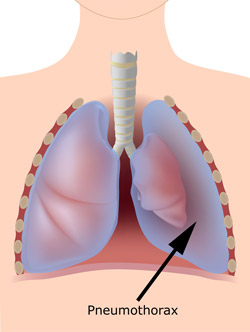Lung injuries
The lungs are a pair of spongy organs that help the body take on oxygen and breathe out carbon dioxide. They inflate and deflate like balloons and can be pierced by sharp pieces of bone from broken ribs or just the impact of a heavy tackle. When burst, this causes a “collapsed lung” or pneumothorax.
Pneumothorax
Casualties with a collapsed lung may complain of sharp chest pain that is worse on taking a breath in. Most young, healthy adults will cope well with a collapsed lung, but they may show the pale, grey/blue colour of cyanosis if they cannot get enough oxygen into the blood with only one working lung. There may be signs of chest wall injury, such as pain and tenderness of a fractured rib that pierced the lung, or chest wall examination may be normal if the pneumothorax was “spontaneous”.

Haemothorax
Bleeding around the lung can also prevent it from working normally. The blood usually comes from a chest wall injury although may come from the lung itself if the bony edges of a rib fracture cut lung tissue. Bleeding into the chest can cause them to breath faster and work harder. The injured side of the chest may not move as well as the uninjured side. They may appear pale due to blood loss out of the circulation. They may show signs of confusion or agitation due to “shock” and lack of oxygenated blood getting to the brain.

All lung injuries should be treated as emergencies and transported safely to hospital via ambulance:
- Sit them up (easier to breath sitting up), if no spinal injury suspected.
- Contact the emergency services.
- Reassure and support them.
- Keep reassessing.